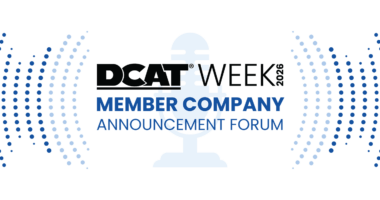What is Next for GlaxoSmithKline?
GlaxoSmithKline’s (GKS) CEO Sir Andrew Witty has announced his intention to retire from the company in early 2017. The board will now conduct a formal search for a successor and will consider internal and external candidates for the role. So what is in store for GSK?
The new CEO will inherit a company seeking to transform itself with a renewed pipeline and recent moves emphasizing a shift from higher-margin, higher-risk pharmaceuticals to higher-volume, lower-margin businesses of consumer healthcare and vaccines. But will this be the formula going forward? DCAT Value Chain Insights (VCI) examines what is in store for a new GSK CEO.
A changing of the guard
When Witty retires next year, he will culminate 32 years with GSK and nearly 10 years as CEO. In a statement, he said: “GSK is a very special company with an inspiring mission and many dedicated people. By next year, I will have been CEO for nearly ten years and I believe this will be the right time for a new leader to take over. In making this decision it has been important to me that the Board have the time to conduct a full and proper process and that we sustain the momentum of our current business performance, capitalizing on the very significant progress we made last year to strengthen the Group. By doing so we will strongly position GSK to achieve the medium-term outlook set out to investors last year and deliver a return to core earnings growth in 2016.”
Recent and future performance
In 2015, GSK posted revenues of £23.9 billion ($33.1 billion), up 6% at constant exchange rates (CER). Pharmaceuticals represent the largest piece of revenue, accounting for 60% of total revenues or £14.2 billion ($20.1 billion), a decline of 7%. Consumer healthcare is the second largest piece at 25% or £6.0 billion ($8.5 billion), which was up 44% in 2015 due to the company’s formation of consumer care joint venture with Novartis. Vaccines represent 15% of revenues or £3.7 billion ($5.3 billion) in 2015, up 19%, also due to the acquisition of Novartis’ vaccines business (excluding flu). In 2015, total operating profit was £10.3 billion ($14.6 billion), but operating profit for core products was down 9% CER to £5.7 billion ($8.1 billion).
Key for GSK going forward is increasing new product sales. Pharmaceuticals turnover was down 7% on a reported basis, primarily reflecting the disposal of its oncology business to Novartis in 2015, a 7% decline in respiratory sales and a 15% decline in sales of established products, largely offset by growth in other new pharmaceuticals products, particularly HIV products Tivicay and Triumeq. Sales of new pharmaceutical products were £1.713 billion ($2.430 billion), an increase of £1.284 billion ($1.821 billion), which more than offset the decline in sales of GSK’s respiratory product, Seretide/ Advair, of £548 million ($777 million). Global Seretide/Advair sales were £3.7 billion ($5.2 billion), down approximately 30% from their peak in 2013 as the products face generic-drug incursion. Key new product sales were from HIV (Tivicay, Triumeq), respiratory (Relvar/Breo, Anoro, Incruse), and meningitis vaccines (Menveo, Bexsero
In 2015, the company estimated its internal rate of return in R&D as approximately 13%. At an R&D event in November 2015, the company identified approximately 40 new medicines or vaccines, 80% of which have potential to be first-in-class.. Up to 10 regulatory filings include Shingrix (shingles vaccine), sirukumab (rheumatoid arthritis), Benlysta SC (lupus) and ICS/LABA/LAMA (chronic obstructive pulmonary disease). Up to 10 Phase lll starts include cabotegravir (HIV), daprodustat (anemia) and Men ABCWY vaccine, and up to 20 Phase ll starts are in immuno-inflammation, oncology, respiratory, and infectious disease. The company points to the potential to file up to 20 assets with regulators by 2020.
GSK is also moving forward with cost-savings plans and other efforts to improve cash flow. In 2015, it gained £6.7 billion ($9.5 billion) as a result of asset disposals in 2015. In 2015, it delivered incremental cost savings of £1 billion ($1.4 billion) and annual costs savings of £3billion ($4.3 billion) by the end of 2017. Overall, the company’s medium-term outlook is to grow core earnings per share (EPS) in the mid-to-high single digits at a compound annual growth rate (CAGR) over five years to 2020.
Key recent deals
The key deal for GSK in 2015 was an asset swap with Novartis under which Novartis acquired certain oncology products and pipeline compounds from GSK, created a consumer healthcare joint venture that combined the two companies’ consumer healthcare divisions, and divested its non-influenza vaccines business to GSK.
Novartis acquired GSK’s oncology products, including two pipeline candidates, for an aggregate cash consideration of $16 billion. Up to $1.5 billion of this amount is contingent on certain development milestones. With the closing of the deal, Novartis’ oncology portfolio now includes 22 oncology and hematology medicines to treat more than 25 conditions. Some key products from GSK’s acquisition include: Tafinlar, a BRAF inhibitor, and Mekinist, a MEK inhibitor, both approved for the treatment of metastatic melanoma; Votrient, a VEGFR inhibitor for treating renal cell carcinoma; Promacta for treating thrombocytopenia; Tykerb for treating HER2+ metastatic breast cancer; and Arzerra for treating chronic lymphocytic leukemia. Novartis also has opt-in rights for GSK’s current and future oncology R&D pipeline (excluding oncology vaccines), which could be a source of new compounds and new targets. Sales of the acquired GSK oncology products in 2014 were approximately $2.0 billion.
In their new consumer healthcare joint venture, GSK Consumer Healthcare, Novartis holds a 36.5% share and GSK the balance. The new joint venture has leading positions in four key over-the-counter categories: wellness, oral health, nutrition, and skin health. The joint venture has scale and commercial presence in the developed world as well as in key emerging markets. Novartis also has four of eleven seats on the joint venture’s board. Furthermore, Novartis has certain minority rights and exit rights, the latter of which would be executed using a pre-defined, market-based pricing mechanism.
As part of the three-part deal, Novartis divested its vaccines business (excluding its vaccines influenza business) to GSK for up to $7.1 billion plus royalties. The $7.1 billion consists of $5.25 billion paid upon completion and up to $1.8 billion in future milestone payments.
Earlier in 2016, GSK also completed its transaction to divest its rights to ofatumumab for auto-immune indications to Novartis Pharma AG, a subsidiary of Novartis AG, following regulatory approval. The consideration payable by Novartis Pharma to GSK may reach up to $1.034 billion and comprises a series of milestone payments as follows: $300 million paid at closing; $200 million payable subject to the start of a Phase III study in relapsing remitting multiple sclerosis by Novartis; and further contingent payments of up to $534 million payable on the achievement of certain other development milestones.





